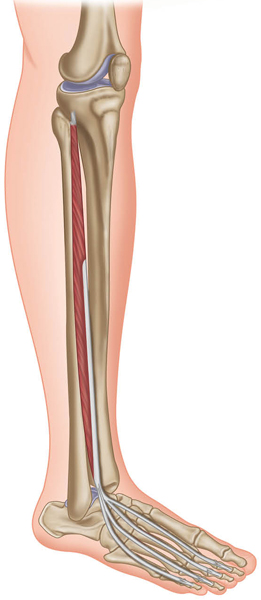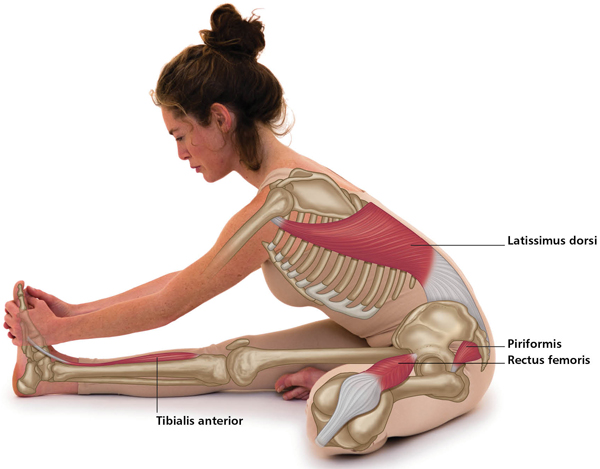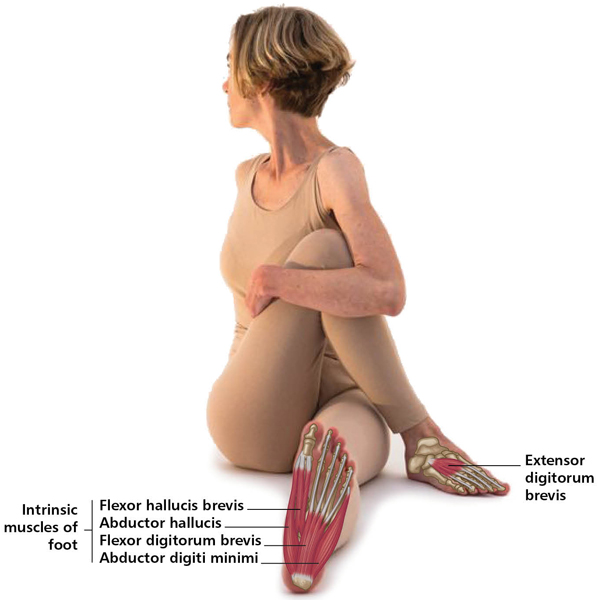10
Muscles of the Lower Leg and Foot
The lower leg and foot support all the structures above them, and this is not an easy task. The arch-like construction of the foot (ankle and toe joints) allows it to perform the functions of support, adaptability, shock absorption, weight transfer, and propulsion. In yoga, the feet are the foundation of many asanas.
Structure
There are 26 bones, 19 large muscles, many small intrinsic muscles on the sole of the foot, and over 100 ligaments that together constitute the main structure of each lower leg/foot. The transfer of weight from the tibia to the talus, and then to the calcaneus (heel bone), is an amazing balancing act as the weight of the entire body is accepted and then propelled forward through the rest of the foot.
The arches are a lesson in architecture. Three arches form a “dome” to perform the necessary functions of the foot. The main longitudinal arch is on the medial side, consisting of the calcaneus on one side and four tarsals on the front, with the talus in the middle acting as the “keystone.” Laterally a longitudinal arch travels from the calcaneus through the talus to the cuboid and fourth and fifth metatarsals. The transverse arch crosses the foot from the big toe to the little toe metatarsal. The action of all the lines of force is centered where the transverse and longitudinal arches meet, accepting body weight from above and ground impact from below. The extrinsic muscles of the foot and the muscles in the sole (intrinsic) reinforce the arches. Put the two feet together, parallel, and a complete dome is formed in the center of both: Tadasana!
Actions
At the upper ankle joint, there is plantar flexion (foot pointed) and dorsiflexion (foot flexed). The lower ankle pronates (a combination of eversion and abduction) and supinates (a combination of inversion and adduction). The toes mainly flex and extend; these actions help spread the toes, a desirable “feat” in yoga.
The muscles of the lower leg will be covered first.

The bones of the foot (lateral view).



Janu Sirsasana (Head to Knee Forward Bend) Level I








Foot
The feet are considered the foundation of most yoga asanas. Beginning with Tadasana (Mountain Pose) as an initial point, the feet are “grounded” through what are called “the four corners of the foot.” Students are asked to become aware of where the weight is being held, and to balance with the toes forward in a parallel position (heels behind toes). The toes are also cued to “spread” (abduction). Once this is experienced, the alignment process travels up through the legs, the pelvis, and the spine in an active manner in order to initiate length, space, and prana up through the body. Feeling the connection to the earth, through the feet, and up and out to the universe is an example of the energetic quality and health benefits of yoga.
The muscles of the foot are listed here and can be referenced in more detail in other sources if needed. Keep in mind there are three main areas: (1) the upper ankle joint, where dorsiflexion and plantar flexion occur; (2) the lower ankle joint, with joint actions of pronation and supination; and (3) the phalanges (toes), with flexion, extension, abduction, and adduction (similar to the fingers). Some of the muscles are multiarticulate, working two or more joints, and have been discussed above in the “Lower Leg” section.
Metatarsophalangeal Joints
Plantar and dorsal interossei muscles (abduct and flex)
Foot Muscles
Intrinsic (sole of foot) and Extrinsic (dorsal side) Hallucis (big toe) muscles: Abductor hallucis, abductor digiti minimi (pinky toe), flexor hallucis brevis, flexor hallucis longus, adductor hallucis, extensor hallucis longus
Toe Flexors
Flexor digitorum brevis, flexor digitorum longus, flexor digiti minimi brevis, quadratus plantae, lumbricales (flex metatarsophalangeal joints)
Toe Extensors
Lumbricales (lateral side toe extension), interossei, extensor digitorum brevis
Toe Abductors
Dorsal interossei

